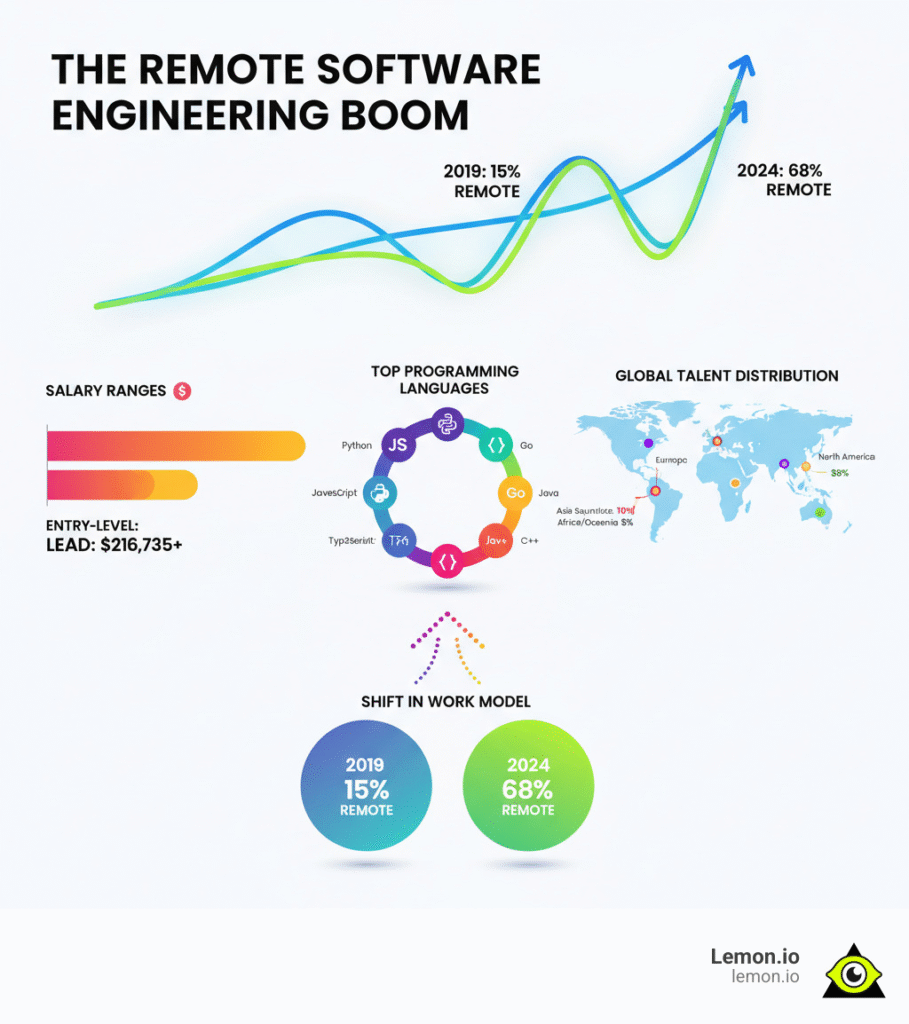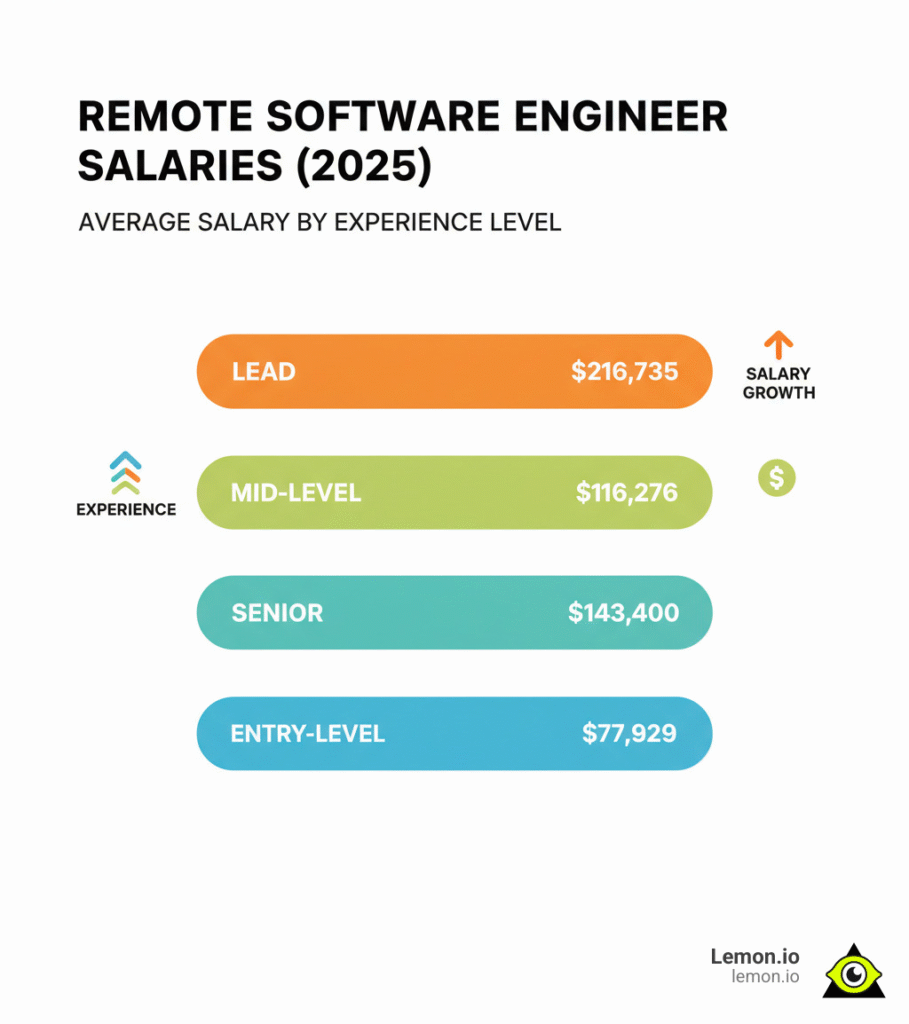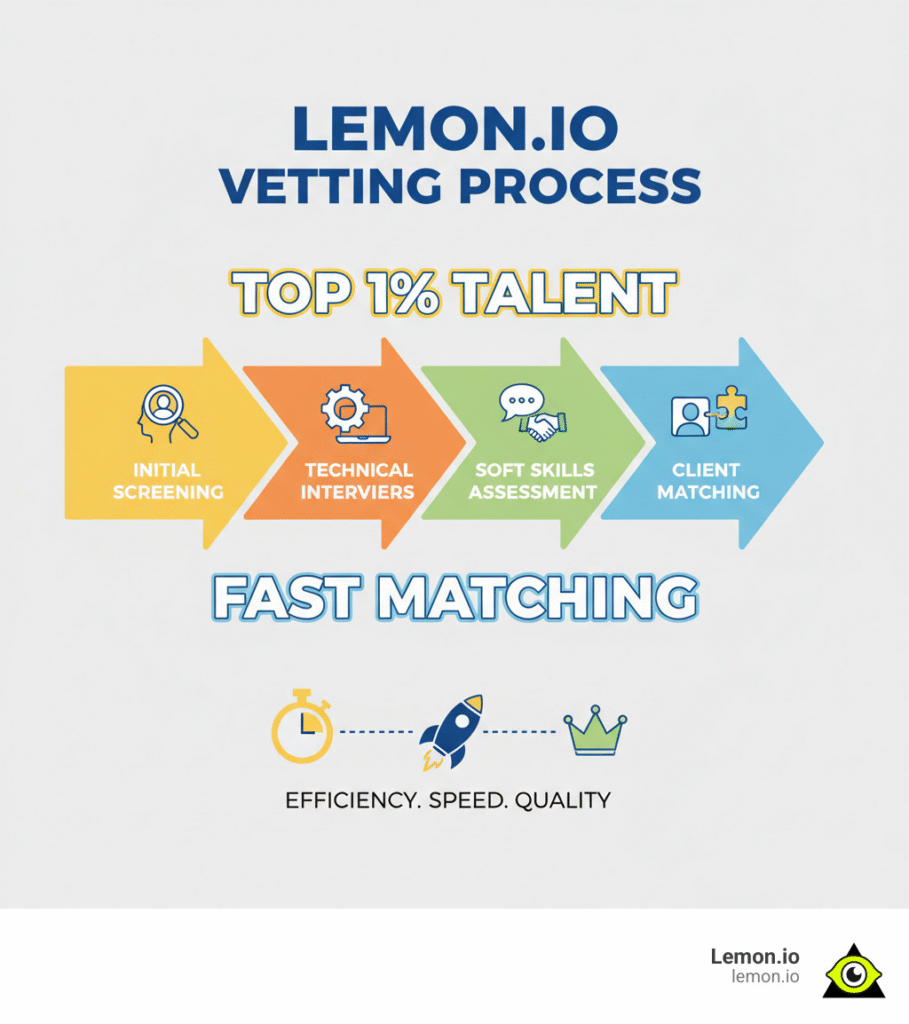Remote software engineers are one of the fastest-growing segments in tech, with thousands of available positions globally. Demand has exploded as companies find they can access top-tier talent without geographic limitations while offering the work-life balance that engineers increasingly prioritize.
Key facts about remote software engineers:
- Salary ranges: Entry-level ($77,929) to Lead engineers ($216,735+)
- Top locations: Toronto, Vancouver, Montreal for Canadian market; global opportunities across 50+ countries
- Most in-demand roles: Full-stack developers, AI engineers, DevOps specialists
- Work models: Fully remote, hybrid-remote, and timezone-flexible arrangements
- Emerging trends: 4-day work weeks, AI-focused specializations, startup equity packages
This shift is more than a pandemic response—it’s a fundamental change in how software is built. Companies from Y Combinator startups to Fortune 500 enterprises now compete for the same global talent pool.
This change creates both opportunities and challenges. While you can recruit a Python expert from Poland or a React specialist from Brazil, you also need to steer time zones, cultural differences, and new employment models.
I’m Aleksandr Volodarsky, and I’ve helped scale Lemon.io from $2.7M to $10M by connecting companies with remote software engineers who deliver results. Through this experience, I’ve seen how the right remote talent can accelerate product development and reduce hiring costs by up to 40%.

The Modern Landscape of Remote Software Engineering
The tech world has seen massive changes, and what was once a niche perk—remote work—is now a core business strategy. This shift allows companies to tap into a richer, more diverse talent pool and build stronger, more innovative teams. We’ve watched remote software engineers completely change companies for the better, bringing in fresh ideas and skills that are hard to find locally.
The perks of going remote extend far beyond skipping the commute. Teams often become more productive, companies save significantly on office costs, and, most importantly, you can hire from a truly global talent pool. Suddenly, you can hire that niche expert in Rust, the seasoned AI engineer, or the full-stack wizard, no matter where they live. This opens up incredible remote software engineering opportunities for building more specialized teams.
This new world, however, requires a smart approach. Success depends on mastering different models—from fully remote to hybrid and timezone-agnostic setups. The key to all of them is effective asynchronous communication: using tools and strategies that let your team collaborate smoothly, even if they’re not online at the same time. It’s about clear messages, great documentation, and a culture of trust.
What’s Driving the Demand for Remote Engineers?
So, what’s really fueling this huge demand for remote software engineers? It’s a mix of powerful trends. First, global competition is tougher than ever. To win, companies need the absolute best minds, and those brilliant developers are no longer concentrated in Silicon Valley. As every business undergoes a digital change, the need for skilled developers has exploded, and remote work is the best way to meet it.
Startup culture has also been a major driver. Nimble companies were among the first to see the power of hiring remote software engineers. Y Combinator startups, for example, accept it for the flexibility and access to a huge talent pool. We’re seeing companies like Keeper, Dex, Windmill, and Saphira AI leading the charge with remote roles.
Finally, flexibility has become a valuable currency. Offering remote work—and even new ideas like the 4-day work week (we’ll dive into that later!)—is a huge magnet for top talent. It shows you care about an engineer’s work-life balance. This flexibility also allows companies to find niche skills that might be impossible to find locally, helping them build specialized and unbeatable teams.
Understanding Remote Work Models
To ace remote hiring, it’s key to understand the different ‘flavors’ of remote work. Knowing the distinctions helps you find the perfect fit for your team.
- Fully Remote: Engineers work from their chosen location 100% of the time, with no expectation of visiting a physical office. This model offers the ultimate flexibility and access to a truly global talent pool, which many top remote software engineers seek.
- Hybrid-Remote: This model blends remote and in-office work. Engineers might come to a central office a few days a week or month for collaborative sessions, team building, or key project milestones. You’ll often see job postings for “Hybrid Remote Work” in a specific city like Toronto.
- Timezone-agnostic: This approach allows engineers to work across different time zones, relying heavily on asynchronous communication and clear documentation. Work can proceed around the clock, making it highly effective for global teams.
- Geographic Considerations: Even ‘remote’ roles can have location requirements. Companies often have preferences or restrictions based on legal rules, taxes, or time zones. Postings might specify “Remote (US)” or “Remote (Canada),” while others are open to candidates “Anywhere in the World.”
- On-site Collaboration Days: A common feature of hybrid models, these are specific days when team members gather in the office to foster in-person connection, brainstorm ideas, and tackle complex challenges together.
In-Demand Skills and Roles: Who to Hire
Finding great remote software engineers means looking beyond coding ability. The ideal candidate combines technical expertise with the soft skills and experience needed to thrive in a distributed team.

While technical skills are crucial, soft skills are paramount for remote success. Clear communication, time management, problem-solving, and cross-timezone collaboration are essential. For remote roles, soft skills are the new hard skills.
Experience level is another key factor. Whether you need an entry-level developer, a mid-senior engineer, or a technical lead will determine the role’s responsibilities and salary.
Common Job Titles for Remote Software Engineers
When searching for remote software engineers, you’ll encounter many job titles, often with “Remote” or “Work From Home” included. Here’s a guide to the most common ones:
- Full-Stack Engineer: A versatile developer who builds both the user-facing (frontend) and server-side (backend) parts of applications.
- Backend Developer: Focuses on the server, databases, APIs, and the core architecture that powers applications.
- Frontend Developer: Specializes in creating the beautiful and intuitive user interfaces for websites and apps.
- DevOps Engineer: Bridges development and operations, automating software delivery and managing infrastructure. Also known as Site Reliability Engineer (SRE).
- AI/Machine Learning Engineer: Designs, builds, and deploys intelligent AI models and systems.
- Mobile Developer (iOS/Android): Crafts applications for mobile platforms like iOS and Android.
- QA Engineer (Quality Assurance): Ensures software quality by testing, identifying bugs, and improving processes.
- Software Architect: A senior planner who designs the high-level structure and technical vision for software systems.
- Other Specialized Roles: You’ll also find niche titles like “Data Engineer,” “UX Developer,” and “Security Software Engineer.”
The Most Sought-After Technical Stacks
For remote software engineers, mastering certain technologies can significantly boost their market value. Here are some of the most in-demand technical stacks:
- Cloud Platforms: Expertise in AWS (Amazon Web Services), GCP (Google Cloud Platform), and Azure is highly sought after, along with experience in container tools like Docker and orchestration systems like Kubernetes.
- Programming Languages: Python and JavaScript remain dominant for backend, AI, and web development. Other in-demand languages include Rust for high-performance systems, Go (Golang) for concurrency, C# for enterprise applications, Java, PHP, TypeScript for code quality, and Swift for iOS development.
- Frameworks & Libraries: The “big three” for frontend are React, Angular, and Vue.js. On the backend, Node.js, Next.js, Ruby on Rails (RoR), and .NET are popular.
- Databases: Proficiency in both relational databases like PostgreSQL and MySQL, and NoSQL options like MongoDB and DynamoDB, is crucial.
- AI & Machine Learning: Familiarity with libraries like TensorFlow and PyTorch is essential. Experience with OpenAI tools and LLMs is also a major plus.
- DevOps Tools: A good grasp of tools like Ansible, Terraform, and various CI/CD pipelines is frequently required.
Experience Levels and Typical Salaries
Understanding salary expectations is crucial for hiring managers and remote software engineers. While salaries vary based on location, company size, and skills, here are general ranges based on today’s market:

- Entry-level (0-1 years experience): The average salary for junior remote software engineers is around $77,929 per year, typically in the $70,000-$90,000 range.
- Mid-Senior level (2-9 years experience): A mid-level engineer (2-4 years) averages $116,276, while a senior engineer (5-9 years) averages $143,400. The combined range is often $110,000-$160,000, with top senior roles reaching $200,000.
- Lead/Staff Engineer (10+ years experience): Seasoned pros who lead teams or set technical direction average $216,735, with top-tier roles hitting $180,000-$250,000+.
Salary variations by location still exist. While remote work aims to flatten global pay, local cost of living and market demand play a part. For instance, Canadian remote roles often list salaries of $100,000+ CAD. In Europe, a senior engineer in Berlin might earn €70,000-€95,000 EUR. US-based remote roles often command the highest salaries.
Beyond salary, equity compensation is a huge draw, especially with startups. Some forward-thinking companies also offer the option to be paid in crypto.
Navigating the Global Talent Pool for Remote Software Engineers
The world became your hiring playground when remote work took center stage. As someone who’s helped scale teams globally, I can tell you there’s nothing quite like finding that perfect remote software engineer who transforms your product – whether they’re coding from a café in Berlin or their home office in Vancouver.
But here’s the thing: having access to global talent is both exciting and overwhelming. You can theoretically hire anyone from anywhere, but the reality involves navigating time zones, cultural nuances, and legal frameworks that vary dramatically from country to country.

The key is understanding where to look and how to evaluate candidates effectively. Some regions have developed into genuine tech powerhouses, while others offer hidden gems of talent at competitive rates. The trick is knowing which markets align with your needs, budget, and company culture.
Top Geographic Hubs for Engineering Talent
When I look at where the best remote software engineers are coming from, certain patterns emerge. These aren’t just random hotspots – they’re regions that have invested heavily in tech education and built thriving developer communities.
Canada stands out as a remarkable success story. With over 3,000+ remote software engineer positions available, it’s become a go-to destination for companies seeking North American talent. Toronto leads with 567 jobs, followed by Vancouver with 226 positions and Montreal with 204 opportunities. What makes Canadian developers particularly attractive is their strong English communication skills and cultural alignment with US companies, plus they’re in favorable time zones for collaboration.
Europe offers incredible diversity and depth. Poland has quietly become a software engineering powerhouse, producing developers who combine technical excellence with strong work ethics. Germany, particularly Berlin, attracts both startups and established companies looking for innovative talent. France is seeing rapid growth in its tech ecosystem, while countries like the Netherlands, Spain, and Portugal contribute significantly to the remote talent pool.
Latin America represents one of the most exciting opportunities for US companies. Brazil, Argentina, Colombia, and Mexico are producing world-class developers who often have excellent English skills and offer competitive rates when paid in USD. The time zone overlap with North America makes collaboration much smoother than working with European or Asian teams.
India remains a massive source of engineering talent across every specialization you can imagine. The sheer volume of skilled developers, combined with competitive pricing and strong technical education, makes it an obvious choice for many companies.
Even within the United States, the remote model has transformed hiring. While San Jose and the San Francisco Bay Area still concentrate many opportunities, companies can now access talent from smaller cities and rural areas where the cost of living is lower but the talent quality remains high.
Challenges and Solutions in Hiring Remotely
Let me be honest – hiring globally isn’t always smooth sailing. I’ve seen companies make costly mistakes by underestimating the challenges involved. But I’ve also seen those same companies succeed brilliantly once they understood what to watch for.
Communication barriers go beyond just language proficiency. Even when everyone speaks English well, cultural communication styles can create misunderstandings. Some cultures are more direct, others more diplomatic. The solution isn’t to avoid these differences but to acknowledge them upfront. We look for strong English communication skills, but more importantly, we assess how well candidates can explain complex technical concepts clearly and concisely.
Cultural fit becomes trickier when your team spans multiple continents. A developer who thrives in a Silicon Valley startup might struggle with the more structured approach of a European enterprise company. The key is being explicit about your company culture during the interview process and looking for candidates who demonstrate adaptability and emotional intelligence.
Time zone coordination can make or break remote teams. Having your lead developer in Ukraine while your product manager is in California creates obvious challenges. The solution isn’t to force everyone into the same hours – that defeats the purpose of remote work. Instead, accept asynchronous workflows, focus on outcomes rather than hours logged, and use tools that keep everyone aligned even when they’re not online simultaneously.
Secure onboarding becomes critical when you’re shipping laptops across borders and giving access to sensitive systems. This requires robust protocols from day one – secure access management, company-issued devices with pre-configured security settings, and clear guidelines about data handling and privacy.
Performance management shifts dramatically in remote settings. You can’t rely on visual cues or casual conversations to gauge how someone is doing. Instead, you need structured check-ins, clear KPIs, and well-defined goals. Trust becomes paramount, but it needs to be backed by transparent results and regular communication.
At Lemon.io, we’ve built our entire process around solving these challenges. Our 100% manual vetting goes far beyond technical skills – we assess communication abilities, cultural adaptability, and the mindset needed to thrive remotely. Our fast matching process means you’re not spending months navigating these complexities yourself. We’ve already done the heavy lifting to identify remote software engineers who are not just technically excellent but truly ready to integrate seamlessly into distributed teams.
The global talent pool for remote software engineers is vast and exciting, but success comes from understanding both the opportunities and the pitfalls. With the right approach and partners, you can build remarkable teams that span the globe.
Emerging Trends Shaping the Future of Remote Development
The landscape of remote software engineering moves faster than a well-optimized algorithm. What feels cutting-edge today becomes standard practice tomorrow. For those of us building teams and scaling companies, staying ahead of these trends isn’t just about keeping up with the cool kids—it’s about creating workplaces that attract the brightest minds and keep them engaged for the long haul.

The future of work is being written right now by forward-thinking companies that understand remote software engineers aren’t just looking for another paycheck. They want meaningful work, flexible schedules, and the chance to grow their skills in emerging technologies. The companies that get this right will win the talent war.
The Rise of the 4-Day Work Week
Here’s a radical idea that’s gaining serious momentum: what if we could get the same (or better) results in four days instead of five? The 4-day work week isn’t just a pipe dream anymore—it’s becoming a competitive advantage for smart companies.
The math is surprisingly simple. When people work fewer hours, they tend to focus better during the time they do work. Less time scrolling social media, fewer coffee breaks that stretch into impromptu brainstorming sessions about last night’s TV show. Productivity vs. hours isn’t a linear relationship, and progressive companies are proving it.
Compressed workweeks come in different flavors. Some companies go with four 10-hour days. Others stick with the traditional 8-hour days but cut out Fridays entirely. We’ve seen companies like Autosoft explicitly highlight their “4 day workweek” alongside unlimited vacation and learning budgets. Other creative approaches include “every 3rd Friday off” or alternating between 4-day and 5-day weeks.
For attracting top talent, this perk is pure gold. When a senior developer is choosing between two similar offers, the extra day off each week often tips the scales. It signals that you trust your team to manage their time and that you value their work-life balance over outdated notions of “butts in seats.”
The improved work-life balance aspect can’t be overstated. That extra day gives people time to recharge, pursue side projects, spend time with family, or simply catch up on life. A well-rested developer is a more creative, productive developer. We’ve seen this trend across various roles, from Junior Software Engineers all the way up to Senior Machine Learning Engineers.
The Growth of Niche Specializations
Gone are the days when “I’m a developer” was a complete job description. Today’s tech landscape demands specialists who can dive deep into specific domains. The demand for AI-focused roles has absolutely exploded, and for good reason.
Companies are scrambling to hire Founding Applied AI Engineers, Machine Learning Researcher Engineers, AI Agent Engineers, and Research Engineer, Applied AI positions. Startups like Relvy AI, Saphira AI, and BoldVoice are offering salaries from $100K to $200K+ for these specialized roles. It’s not just about building new AI features—we’re seeing AI transform fundamental aspects of software development.
Web3 and Blockchain developers continue to carve out their niche, despite market volatility. The underlying technology remains compelling for companies building decentralized applications and exploring new business models.
Cybersecurity experts have never been more crucial. Every week brings news of another data breach, making roles like “Security Software Engineer” and “Senior Security Architect” absolutely essential. Companies realize that security isn’t something you bolt on afterward—it needs to be baked into every line of code.
Data Engineers are the unsung heroes of the modern tech stack. While everyone talks about data-driven decisions, someone has to build the pipelines and infrastructure that make those insights possible. Senior Data Scientists and Data Engineers are creating the foundation for everything from business intelligence to machine learning models.
The impact of AI on debugging and incident response represents one of the most exciting developments we’re seeing. Companies like Relvy AI are working on “AI powered debugging notebooks” that can help engineers identify and fix issues faster than ever before. This isn’t replacing human expertise—it’s amplifying it, allowing remote software engineers to focus on solving complex problems rather than hunting through logs for hours.
These specializations represent more than just trendy job titles. They’re responses to real business needs and technological shifts that are reshaping entire industries. For hiring managers, understanding these niches means being able to attract the right talent at the right time. For engineers, developing expertise in these areas can significantly boost both career prospects and earning potential.
Conclusion
Phew, we’ve covered a lot of ground, haven’t we? The world of remote software engineers isn’t just growing; it’s practically bursting with innovation and opportunity. We’ve journeyed through the modern landscape, peeked at what’s driving this incredible demand, explored the diverse roles and in-demand skills, and even caught a glimpse of exciting trends shaping the future – from cutting-edge AI to the tempting promise of a 4-day work week. It’s clearer than ever that remote work isn’t just a passing trend; it’s a powerful, evolving force that’s here to stay.
For you, as a hiring manager, this means an amazing chance to tap into a truly global talent pool. Imagine finding that perfect blend of skills, experience, and cultural fit for your team, no matter where they are in the world! Of course, it’s not without its quirks. You might wonder about navigating different time zones or ensuring everyone communicates seamlessly. And that’s totally fair.
But here’s the good news: you don’t have to tackle those challenges alone. That’s exactly where we come in. At Lemon.io, we’re passionate about connecting companies like yours with truly exceptional remote software engineers. Our secret sauce is simple: we offer fast matching, so you won’t miss out on top talent. We give you month-to-month flexibility, meaning you can scale your team up or down precisely as you need. And perhaps most importantly, our 100% manual vetting process guarantees that you’re engaging with the top 1% of engineering talent out there. We’re here to help you open up the incredible potential of global development and build those innovative, successful remote teams you dream of.
Ready to find your next engineering superstar and boost your projects?
Hire vetted offshore developers











